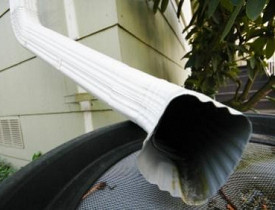Harvesting Rainwater

After rainstorms, many homeowners have mudholes under downspouts and sidewalks full of runoff. The day after watching gallons of water go to waste, it's back to watering with filtered drinking water. The environmentally responsible and financially sensible alternative is to harvest rainwater. Rainwater harvesting systems can be as simple as a collection barrel or as complex as a professionally landscaped trench garden weaving through the yard. There are a few legal and practical issues related to harvesting rainwater, but it can be an effective money- and water-saving option for most homeowners with landscaping.
Why Harvest Rainwater
Each gallon of harvested rainwater equals a gallon of treated city water that can be put to better use. Harvesting rainwater saves municipalities money and, in turn, should reduce homeowners' water bills. Harvesting rainwater also helps reduce erosion and evaporation due to heavy rain runoff. Saving rainwater and distributing it more efficiently helps plant growth by washing salts down below plant roots the soil. It also helps feed more water into the water table, and keeps fertilizers and pesticides out of streams and groundwater.
How to Harvest Rainwater
The image often associated with harvesting rainwater is a barrel under the gutter downspout. High-quality rainwater barrels cost about $100 and include a spigot to fill watering cans or attach a hose. Crafty homeowners can build their own barrels or customize a large garbage can or plastic drum. Another way to divert water from roofing gutters may involve a professional landscape designer. Rain gardens look like sunken rivers or lakes of plants. The garden should be at least three inches below the main level of the yard, mulched and scattered with native plants.
To keep water from building up around the foundation of the home, dig out a channel at least one foot long to the rain garden area or develop the whole rain garden as a river-like trench. Ambitious gardeners also can harvest rainwater that is already falling on the yard. A series of crescent-shaped depressions will catch runoff so it can seep into the ground and feed nearby plants. The removed soil can form small berms behind the depressions.
Rainwater Harvesting Warnings
Homeowners should heed a few warnings before building a rainwater barrel. Avoid clear containers to prevent algae growth, and cover the top and all other openings to keep debris and mosquitoes out of the barrel. Mosquitoes can carry the West Nile virus and will turn a rain barrel into a breeding pond.
There also is a patchwork of rainwater harvesting laws in the arid western United States, where the practice is most useful. In every state west of the Rocky Mountains, water law is dauntingly complex. Every drop of rainfall is subject to water rights often stretching back 100 years.
It is illegal in Colorado and Utah to harvest rainwater in barrels (though constructing small depressions and berms is approved) because homeowners typically do not own water rights. On the other hand, cities in Arizona and New Mexico require rainwater harvesting for some new construction projects. Texas offers business tax rebates for large-scale collection systems.
Looking for a Pro? Call us (866) 441-6648

Landscaping Average Costs
Landscapers Experiences

Siding And Roof Replacement By The Same Contractor

My Roof Repair -- No More Rain In The House Since We Got Our Roof Fixed



